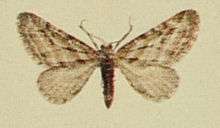Eupithecia extensaria
Eupithecia extensaria, the scarce pug, is a moth of the family Geometridae. The species was first described by Christian Friedrich Freyer in 1844. It is found in the British Isles (rare, and confined to eastern saltmarshes), Spain and eastern Europe.[2]
| Eupithecia extensaria | |
|---|---|
 | |
| Scientific classification | |
| Kingdom: | Animalia |
| Phylum: | Arthropoda |
| Class: | Insecta |
| Order: | Lepidoptera |
| Family: | Geometridae |
| Genus: | Eupithecia |
| Species: | E. extensaria |
| Binomial name | |
| Eupithecia extensaria | |
| Synonyms | |
| |
The wingspan is 21–25 mm.[3] The moth flies in both May and June.
The larvae feed on sea wormwood (Artemisia maritima).[3][4]
Subspecies
- Eupithecia extensaria extensaria
- Eupithecia extensaria leuca Dietze, 1910
- Eupithecia extensaria occidua Prout, 1914
gollark: Mostly fine. It's better than school, at least. It would be nice if I could actually try some new activities or something though, since that stuff seems to mostly be shut down.
gollark: I am hoping that whoever is behind that won't decide to try something like this again, but I bet *someone* will think "ah yes, this is a great idea, we'll just lie because it's mildly more convenient, that can't go wrong in the long term".
gollark: ... yes, that.
gollark: It probably doesn't help that apparently some people said they were unhelpful in order to ensure that healthcare people had enough.
gollark: There was a lot of confusion about this initially but the consensus seems to have converged on them being useful.
References
- Yu, Dicky Sick Ki. "Eupithecia extensaria (Freyer 1844)". Home of Ichneumonoidea. Taxapad. Archived from the original on 24 March 2016.
- Savela, Markku. "Eupithecia extensaria (Freyer, 1844)". Lepidoptera and Some Other Life Forms. Retrieved 29 April 2019.
- Ian Kimber. "1847 Scarce Pug Eupithecia extensaria". UKMoths. Retrieved 26 January 2013.
- Wikisource:The Moths of the British Isles Second Series/Chapter 9#238
| Wikimedia Commons has media related to Eupithecia extensaria. |
| Wikispecies has information related to Eupithecia extensaria |
This article is issued from Wikipedia. The text is licensed under Creative Commons - Attribution - Sharealike. Additional terms may apply for the media files.